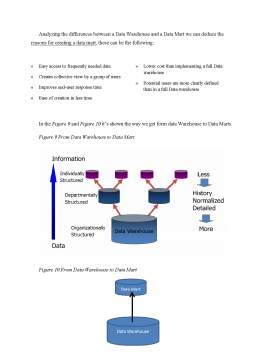Cuprins
- Introduction 3
- What is Data Warehouse? 4
- What is Data Warehousing? 6
- Functions of Data Warehouse 7
- Business Benefits and Problems of using Data Warehouse 10
- Evolution in organizational use of data warehouse 11
- Applications of Data Warehouse 12
- Data Warehouse Architecture 15
- What is Data Mart? 18
- Conclusion 20
Extras din referat
Introduction
We all know the benefits of Data Bases, using them in any business made the life of the companies much easier. Data Warehouses are another kind of environment that give us benefits. They are designed to give the company the possibility to analyze the data which was transacted. Another function of Data Warehouses is being a store of data obtained from a variety of different sources made available to end users in what they can understand and use in a business context.
In the text below we will try to understand the concept of Data Warehousing, its functionality, the benefits and the problems which can appear while using it, its architecture and how it can be applied. We will analyze the evolution in organizational use of Data Warehousing and see how and in which field it can be implemented in organizations. At the same time we will get to know more about the applications Of Data Warehouses where one of them is Data Mart - a simple form of a Data Warehouse that is focused on a single subject.
What is Data Warehouse?
A data warehouse is a central repository for all or significant parts of the data that an enterprise's various business systems collect. A Data Warehouse is a relational database that is designed for query and analysis rather than for transaction processing. It usually contains historical data derived from transaction data, but it can include data from other sources. It separates analysis workload from transaction workload and enables an organization to consolidate data from several sources.
Typically, a data warehouse is housed on an enterprise mainframe server. Data from various online transaction processing (OLTP) applications and other sources is selectively extracted and organized on the data warehouse database for use by analytical applications and user queries.
A common way of introducing data warehousing is to refer to the characteristics of a data warehouse as set forth by William Inmon:
- Subject Oriented
- Integrated
- Nonvolatile
- Time Variant
Subject Oriented
Data warehouses are designed to help you analyze data. For example, to learn more about your company's sales data, you can build a warehouse that concentrates on sales. Using this warehouse, you can answer questions like "Who was our best customer for this item last year?" This ability to define a data warehouse by subject matter, sales in this case, makes the data warehouse subject oriented.
Integrated
Integration is closely related to subject orientation. Data warehouses must put data from disparate sources into a consistent format. They must resolve such problems as naming conflicts and inconsistencies among units of measure. When they achieve this, they are said to be integrated.
Nonvolatile
Nonvolatile means that, once entered into the warehouse, data should not change. This is logical because the purpose of a warehouse is to enable you to analyze what has occurred.
Time Variant
In order to discover trends in business, analysts need large amounts of data. This is very much in contrast to online transaction processing (OLTP) systems, where performance requirements demand that historical data be moved to an archive. A data warehouse's focus on change over time is what is meant by the term time variant.
Preview document
Conținut arhivă zip
- Data Warehouses.docx
































